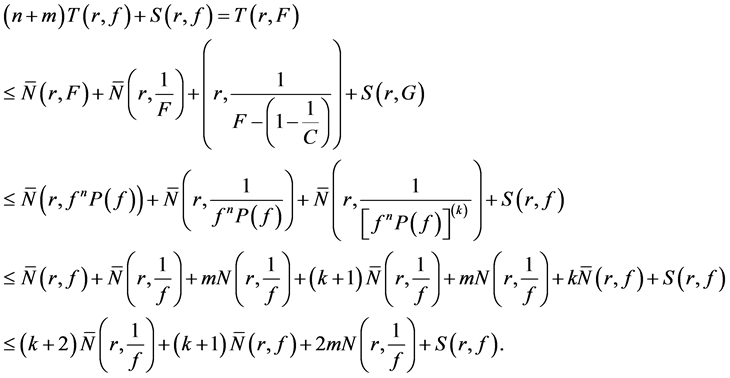Applied Mathematics
Vol.06 No.12(2015), Article ID:61202,10 pages
10.4236/am.2015.612178
On Meromorphic Functions That Share One Small Function of Differential Polynomials with Their Derivatives
Harina P. Waghamore, S. Rajeshwari
Department of Mathematics, Central College Campus, Bangalore University, Bangalore, India

Copyright © 2015 by authors and Scientific Research Publishing Inc.
This work is licensed under the Creative Commons Attribution International License (CC BY).
http://creativecommons.org/licenses/by/4.0/



Received 19 August 2015; accepted 15 November 2015; published 18 November 2015
ABSTRACT
In this paper, we study the problem of meromorphic functions that share one small function of differential polynomial with their derivatives and prove one theorem. The theorem improves the results of Jin-Dong Li and Guang-Xin Huang [1] .
Keywords:
Uniqueness, Meromorphic Function, Differential Polynomial

1. Introduction and Results
Let  denote the complex plane and f be a nonconstant meromorphic function on
denote the complex plane and f be a nonconstant meromorphic function on . We assume the reader is familiar with the standard notion used in the Nevanlinna value distribution theory such as
. We assume the reader is familiar with the standard notion used in the Nevanlinna value distribution theory such as 
 (see, e.g., [2] [3] ), and
(see, e.g., [2] [3] ), and  denotes any quantity that satisfies the condition
denotes any quantity that satisfies the condition  as
as  outside of a possible exceptional set of finite linear measure. A meromorphic function a is called a small function with respect to f, provided that
outside of a possible exceptional set of finite linear measure. A meromorphic function a is called a small function with respect to f, provided that .
.
Let f and g be two nonconstant meromorphic functions. Let a be a small function of f and  We say that f, g share a counting multiplicities (CM) if
We say that f, g share a counting multiplicities (CM) if  have the same zeros with the same multiplicities and we say that f, g share a ignoring multiplicities (IM) if we do not consider the multiplicities. In addition, we say that f
have the same zeros with the same multiplicities and we say that f, g share a ignoring multiplicities (IM) if we do not consider the multiplicities. In addition, we say that f
and g share ¥ CM, if  share 0 CM, and we say that f and g share ¥ IM, if
share 0 CM, and we say that f and g share ¥ IM, if  share 0 IM. Suppose that f and g share a IM. Throughout this paper, we denote by
share 0 IM. Suppose that f and g share a IM. Throughout this paper, we denote by  the reduced counting function of those common a-points of f and g in
the reduced counting function of those common a-points of f and g in , where the multiplicity f each a-point of f is greater than that of the corresponding a-point of g, and denote by
, where the multiplicity f each a-point of f is greater than that of the corresponding a-point of g, and denote by  the counting function for common simple 1-point of both f and g, and
the counting function for common simple 1-point of both f and g, and 



In addition, we need the following definitions:
Definition 1.1. Let f be a non-constant meromorphic function, and let p be a positive integer and 










Definition 1.2. Let f be a non-constant meromorphic function, and let a be any value in the extended complex plane, and let k be an arbitrary nonnegative integer. We define
where
Remark 1.1. From the above inequalities, we have
Definition 1.3. Let f be a non-constant meromorphic function, and let a be any value in the extended complex plane, and let k be an arbitrary nonnegative integer. We define
Remark 1.2. From the above inequality, we have
Definition 1.4. (see [4] ). Let k be a nonnegative integer or infinity. For 





We write f, g share 





R. Bruck [5] first considered the uniqueness problems of an entire function sharing one value with its derivative and proved the following result.
Theorem A. Let f be a non-constant entire function satisfying


Bruck [5] further posed the following conjecture.
Conjecture 1.1. Let f be a non-constant entire function 



Yang [6] proved that the conjecture is true if f is an entire function of finite order. Yu [7] considered the problem of an entire or meromorphic function sharing one small function with its derivative and proved the following two theorems.
Theorem B. Let f be a non-constant entire function and 




Theorem C. Let f be a non-constant non-entire meromorphic function and 
1) f and a have no common poles.
2) 

3)
then 
In the same paper, Yu [7] posed the following open questions.
1) Can a CM shared be replaced by an IM share value?
2) Can the condition 
3) Can the condition 3) in theorem C be further relaxed?
4) Can in general the condition 1) of theorem C be dropped?
In 2004, Liu and Gu [8] improved theorem B and obtained the following results.
Theorem D. Let f be a non-constant entire function 




Lahiri and Sarkar [9] gave some affirmative answers to the first three questions improving some restrictions on the zeros and poles of a. They obtained the following results.
Theorem E. Let f be a non-constant meromorphic function, k be a positive integer, and 
1) a has no zero (pole) which is also a zero (pole) of f or 
2) 

3) 

In 2005, Zhang [10] improved the above results and proved the following theorems.
Theorem F. Let f be a non-constant meromorphic function, 






or 

or 

then
In 2015, Jin-Dong Li and Guang-Xiu Huang proved the following Theorem.
Theorem G. Let f be a non-constant meromorphic function, 








or 

then
In this paper, we pay our attention to the uniqueness of more generalized form of a function namely 

Theorem 1.1. Let f be a non-constant meromorphic function, 








or 

then
Corollary 1.2. Let f be a non-constant meromorphic function, 





or 
or 
then
2. Lemmas
Lemma 2.1 (see [1] ). Let f be a non-constant meromorphic function, 
clearly
Lemma 2.2 (see [1] ). Let

where F and G are two non constant meromorphic functions. If F and G share 1 IM and
Lemma 2.3 (see [11] ). Let f be a non-constant meromorphic function and let
be an irreducible rational function in f with constant coefficients 



where
3. Proof of the Theorem
Proof of Theorem 1.1. Let 



Case 1. Let
By our assumptions, H have poles only at zeros of 


here 


Because F and G share 1 IM, it is easy to see that

By the second fundamental theorem, we see that

Using Lemma 2.2 and (11), (12) and (13), we get

We discuss the following three sub cases.
Sub case 1.1.

Combining (14) and (15), we get

that is
By Lemma 2.1 for
So
which contradicts with (7).
Sub case 1.2.

and

Combining (14) and (17) and (18), we get

that is
By Lemma 2.1 for
So
which contradicts with (8).
Sub case 1.3.


Similarly we have

Combining (14) and (20)-(22), we get

that is
By Lemma 2.1 for 

So
which contradicts with (9).
Case 2. Let
on integration we get from (10)

where C, D are constants and

Sub case 2.1. Suppose








and

Since
Suppose
Using the second fundamental theorem for F we get
i.e.,
So, we have 

If 

and from which we know 

We know from (28) that
So from Lemma 2.1 and the second fundamental theorem we get
which is absurd. So 

In view of the first fundamental theorem, we get from above
which is impossible.
Sub case 2.2. 
If 
and
By the second fundamental theorem and Lemma 2.1 for 
Hence
So, it follows that
and
This contradicts (7)-(9). Hence 


Cite this paper
Harina P. Waghamore,S. Rajeshwari, (2015) On Meromorphic Functions That Share One Small Function of Differential Polynomials with Their Derivatives. Applied Mathematics,06,2004-2013. doi: 10.4236/am.2015.612178
References
- 1. Li, J.-D. and Huang, G.-X. (2015) On Meromorphic Functions That Share One Small Function with Their Derivatives. Palestine Journal of Mathematics, 4, 91-96.
- 2. Hayman, W.K. (1964) Meromorphic Functions. Clarendon Press, Oxford.
- 3. Yang, L. (1993) Value Distribution Theory. Springer Verlag, Berlin.
- 4. Lahiri, I. (2001) Weighted Sharing and Uniqueness of Meromorphic Function. Nagoya Mathematical Journal, 161, 193-206.
- 5. Bruck, R. (1996) On Entire Functions Which Share One Value CM with Their First Derivative. Results in Mathematics, 30, 21-24.
http://dx.doi.org/10.1007/BF03322176 - 6. Yang, L.Z. (1999) Solution of a Differential Equation and Its Applications. Kodai Mathematical Journal, 22, 458-464.
http://dx.doi.org/10.2996/kmj/1138044097 - 7. Yu, K.W. (2003) On Entire and Meromorphic Functions That Share Small Functions with Their Derivatives. Journal of Inequalities in Pure and Applied Mathematics, 4.
http://jipam.vu.edu.au/ - 8. Liu, L.P. and Gu, Y.X. (2004) Uniqueness of Meromorphic Functions That Share One Small Function with Their Derivatives. Kodai Mathematical Journal, 27, 272-279.
http://dx.doi.org/10.2996/kmj/1104247351 - 9. Lahiri, I. and Sarkar, A. (2004) Uniqueness of Meromorphic Function and Its Derivative. Journal of Inequalities in Pure and Applied Mathematics, 5.
http://jipam.vu.edu.au/ - 10. Zhang, Q.C. (2005) Meromorphic Function That Shares One Small Function with Their Derivatives. Journal of Inequalities in Pure and Applied Mathematics, 6.
http://jipam.vu.edu.au/ - 11. Mohon’ko, A.Z. (1971) On the Nevanlinna Characteristics of Some Meromorphic Functions. Theory of Functions, Functional Analysis and Its Applications, 14, 83-87.


















































